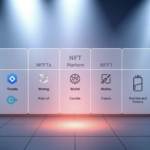Now Reading: How AI Crypto Tokens Work in Blockchain Ecosystems Explained
- 01
How AI Crypto Tokens Work in Blockchain Ecosystems Explained
How AI Crypto Tokens Work in Blockchain Ecosystems Explained

This short guide explains the scope and purpose of a practical primer on tokens that enable on-chain artificial intelligence capabilities. It highlights real projects such as The Graph (GRT), Render (RNDR), and Fetch.ai (FET) as examples of on-chain utilities, from indexing and GPU rendering to autonomous agents.
Readers in the United States will learn about token utilities, smart-contract payments for AI tasks, and safe steps to acquire and store digital assets that power distributed compute and model access. The section frames the role these assets play in coordinating compute, storage, model access, and service payments across permissionless networks.
Expect clear guidance on fundamentals, mechanics, key platforms, buying steps, DeFi uses, evaluation criteria, and risks. The write-up stresses that market capitalization alone can mislead; true value depends on real utility, adoption, and traction across diverse use cases such as indexing, rendering, training, and agent execution.
Key Takeaways
- Focus on projects with real on-chain services, not pure hype.
- Understand token utilities and smart-contract payment flows.
- Evaluate technology, adoption, and market traction beyond market cap.
- Follow secure buying and storage steps covered later in the guide.
- Use case diversity maps to different token models and value drivers.
Understanding the basics: AI tokens, blockchain technology, and where they intersect
Begin with the simple idea that utility coins buy compute and data, and smart contracts enforce the rules.
Utility assets grant access to models, datasets, and automation tools. Users pay with tokens for inference, training, or dataset access. Contributors who supply models or labeled data earn rewards when services run.
Blockchains provide tamper-resistant ledgers that log usage and payouts. That ledger transparency helps align incentives and reduces platform risk through open standards and composability.
Smart contracts automate deposits, metered usage, refunds, and revenue splits. Permission checks on-chain gate access keys and endpoints so developers and users get entitlements without custodial intermediaries.
- Billing units: compute seconds, GPU-hours, and storage GB-months enable microtransactions.
- Data flows: request → payment → processing → reward distribution.
- Automation extends to workflow orchestration for repeatable pipelines.
| Component | Role | Typical Unit |
|---|---|---|
| Models / Inference | Provide predictions and services | Inference calls |
| Data Markets | Host datasets, metadata, and licensing | Dataset access events |
| Payments | Enforce fees and splits via smart contracts | Microtransaction units |
| Compute Networks | Execute jobs and meter usage | GPU-hours / seconds |
Why AI plus blockchain creates unique value for decentralized applications
Combining immutable ledgers with predictive models creates a new trust layer for decentralized services. This blend gives developers verifiable records and models that add real-time insight.
Data integrity and transparency meet machine learning and automation
Immutable logs protect usage records and revenue splits. That makes disputes rare and outcomes auditable.
Verifiable datasets on-chain reduce disagreement over results. Contributors see clear metrics and fair pay. DAOs can then allocate funding to models that prove impact.
- dApps gain predictive power from machine learning while keeping tamper-proof trails for every transaction.
- Automated workflows trigger model calls, enrich user experiences, and record outputs for review.
- Composability lets projects plug into shared services and speed innovation across the market.
| Benefit | Effect | Example Metric |
|---|---|---|
| Immutable logs | Verifiable usage and payouts | Call receipts per job |
| Model evaluation | DAO funding for high-impact services | Accuracy gains / revenue share |
| Composable services | Faster integration, less duplication | Time-to-deploy (days) |
How AI crypto tokens work in blockchain ecosystems
At their core, these systems link model inference, decentralized data stores, and metered compute through automated contracts.
Core components
Models, data markets, compute networks, and smart contracts form the stack. Models deliver predictions, marketplaces sell labeled datasets, and distributed GPUs run jobs. Smart contracts add automation for access and payment.
Utility design
Utility covers inference calls, training runs, dataset access, storage, and extra services like indexing or hosting. Users pay with tokens for processing and platform features. Providers earn when jobs complete successfully.
Reward loops
Metering verifies usage and escrows funds; payouts release after validation. Networks use staking or reputation to surface higher-quality models. Contributors upload models, curate data, validate outputs, or supply compute/storage and earn rewards.
- Interoperability lets platforms source compute from networks while hosting weights on decentralized storage.
- DAO governance can reallocate emissions or grants toward high-demand components.
| Component | Role | Typical Unit |
|---|---|---|
| Models | Inference & training | Calls / jobs |
| Data markets | Dataset access | Downloads / licenses |
| Compute | Execute processing | GPU-hours |
Token mechanics that power decentralized AI services
Clear token mechanics turn platform fees and rewards into predictable incentives for users and providers. A thoughtful design channels demand toward real utility: paying for compute, storage, and model calls rather than speculation.

Utility-first purpose and cross-chain reach
Utility-first design makes tokens useful at the point of service. When tokens are spent to run jobs, label data, or store models, demand links directly to platform activity.
Interoperability with chains like Ethereum and Cosmos expands access. Cross-chain bridges lower friction and grow the addressable user base for services.
Supply, emissions, and incentive alignment
Supply caps and emission schedules control inflation and fund early growth through contributor rewards. Proper emissions subsidize onboarding without collapsing long-term value.
Well-designed mechanics pair sinks—spending for compute and storage—with staking or rewards that favor consistent production workloads. That alignment encourages ongoing participation and shared upside as the market matures.
- Fee models: flat-rate, metered per call, or tiered subscriptions enforced on-chain.
- Sinks tied to real consumption stabilize demand and curb speculative pressure.
- Interoperability boosts reach and practical adoption across platforms.
| Fee model | Example | Benefit |
|---|---|---|
| Metered per call | Per-inference billing | Pay for use, predictable costs |
| Tiered subscription | Monthly access plans | Stable revenue, bulk discounts |
| Flat-rate | Fixed job fee | Simple pricing for users |
Key platforms and protocols enabling AI on-chain
A set of specialized platforms and protocols now link compute, storage, indexing, and agent services for on-chain model usage.
Render Network (RNDR) tokenizes access to distributed GPUs. Providers offer rendering and training capacity; buyers pay with coins to run inference or heavy render jobs. This on-demand compute model supports both graphics and model workloads.
The Graph (GRT) accelerates dApp development with subgraphs and efficient indexing. Developers query indexed data from multiple chains quickly, making real-time analytics and data-driven features practical for applications that rely on ledger records.
Fetch.ai (FET) enables autonomous agents that transact, process data, and coordinate tasks. Agents use tokenized incentives to offer services like routing, prediction, or marketplace matching without centralized intermediaries.
- Filecoin (FIL) hosts large datasets and model artifacts in decentralized storage markets for reproducible pipelines.
- NEAR & Internet Computer (ICP) provide low-latency, scalable smart contract platforms suited to hosting model services and app logic.
- Bittensor (TAO) runs a decentralized machine learning market where useful model contributions earn rewards through a staking-based system.
Composability matters. Developers can combine Filecoin for storage, RNDR for compute, and GRT for indexing to build full services. These platforms form an interoperable stack that expands the practical reach of on-chain model-driven applications across the broader ecosystem.
From idea to token: how AI crypto tokens are created and distributed
A viable launch ties supply, reward mechanics, and governance to measurable platform outputs. Teams start by defining token economics, initial supply, vesting schedules, and the on-chain rules that enforce them.

Initial issuance and smart controls
Deploying smart contracts encodes supply caps, minting rules, and vesting. Clear documentation and third-party audits reduce launch risk.
Distribution and rewards
Common channels include staking rewards for validators, contributor grants, and programmatic payouts to model or data providers. These rewards align incentives on the platform.
Governance and long-term health
DAOs vote on emissions, treasury grants, and developer funding. Aligning early allocations with long-term participation cuts sell pressure and supports network stability.
- Best practices: publish whitepapers, run audits, and disclose vesting.
- Link contributor rewards to verifiable outputs like model performance or verified data quality.
| Component | Role | Example |
|---|---|---|
| Initial supply | Defines scarcity | Fixed cap + vesting |
| Staking | Secures network | Validator rewards |
| DAO treasury | Funds growth | Grants & emissions |
Step-by-step: how to buy and store AI crypto tokens safely
A safe purchase starts with choosing a U.S.-compliant platform that follows clear custody and KYC rules.
Choose a reputable exchange. Pick U.S.-licensed platforms such as Coinbase, Kraken, or Binance US. Check listings, fees, insurance, and past security practices before you fund an account.
Fund and trade. Deposit fiat via ACH, wire, or card, or transfer existing cryptocurrency to your account. Select the correct trading pair and place a market or limit order. Review slippage, fee breakdown, and final price before confirming.
Wallet setup and withdrawals. Use a reputable noncustodial wallet that supports ERC-20 and other networks you need. Verify contract addresses, network, and ticker when creating a withdrawal.
- Test small withdrawals first, then move larger balances once confirmed.
- Allowlist withdrawal addresses where the platform offers it.
Cold storage and operational security. For long-term holding, use hardware wallets and strong passphrases. Keep offline backups of seed phrases and store them securely.
Basic operational hygiene. Use a unique email, strong two-factor authentication, and phishing-aware practices. Regularly review account access and withdrawal history to reduce risks for investors and users.
| Step | Action | Benefit |
|---|---|---|
| Exchange choice | Pick U.S.-compliant platform | Regulatory clarity and insurance options |
| Funding | ACH, wire, card, or crypto deposit | Flexible paths to trade pairs |
| Execution | Market or limit order; check fees | Control over price and slippage |
| Storage | Noncustodial wallet; hardware for cold | Reduced exchange and wallet risks |
Using tokens on AI platforms and decentralized applications
Practical spending flows let participants buy compute time, request model calls, or access datasets with a single on-chain payment.

Users can purchase GPU minutes on platforms like RNDR, submit inference calls, or launch training jobs that meter consumption in real time.
Payments move from wallet to smart contract, which escrows funds, triggers processing, and releases rewards after verification.
Staking and participating in data marketplaces
Marketplaces let contributors list datasets, set access prices, or stake to signal quality. Buyers pay to consume labeled data and may reward curators for high-quality listings.
Ocean Protocol and Filecoin are common examples where staking and marketplace mechanics align incentives for dataset providers.
- Buy GPU time, submit inference calls, or start training with metered payments recorded on-chain.
- List datasets, purchase access, or stake to earn rewards and boost discoverability.
- Use automation to schedule recurring jobs; smart contracts trigger model runs and data refreshes.
| Action | On-chain effect | Benefit |
|---|---|---|
| GPU rental | Escrow → execution → receipt | Predictable cost for heavy compute |
| Dataset purchase | Access token + usage log | Verifiable rights and payments |
| Staking | Priority + reward eligibility | Signals quality and aligns incentives |
On-chain proof of usage provides receipts for accounting and cost analysis. That record helps teams reconcile spend and optimize recurring workloads.
Practical tip: verify network support and approved dApp endpoints before you authorize transactions to avoid misroutes and loss.
The role of AI in DeFi: smarter trading, lending, and risk management
Machine-driven models scan markets and execute orders around the clock to capture fleeting opportunities.
24/7 trading and automation advantages
Automated strategies run continuously across venues. They scan order books, price feeds, and news to react faster than manual traders.
Trading agents can enforce stop-losses, adjust position sizing, and rebalance portfolios via smart contracts. This reduces manual latency and emotional errors.
Credit scoring, rate setting, and risk analytics
Models evaluate borrower profiles and on-chain behavior to suggest credit scores and dynamic rates. Lenders use these scores to stabilize liquidity and reduce defaults.
Risk pipelines combine on-chain flows, volatility metrics, liquidation history, and protocol health for robust data analysis. These analytics inform margin limits and collateral requirements.
- Strategies blend technical indicators, sentiment signals, and order-book depth to improve signal quality.
- Automated agents execute trades and lending actions with programmable guardrails.
- Backtesting and paper trading are essential before deploying capital at scale.
| Function | Data Inputs | On-chain Action |
|---|---|---|
| Trading signals | Price feeds, order-book depth, sentiment | Execute orders via smart contracts |
| Credit scoring | Repayment history, collateral ratios, tx flows | Adjust interest rates; set limits |
| Risk monitoring | Volatility, liquidation events, protocol metrics | Trigger liquidations or alerts |
Benefits: faster execution for volatile assets, tighter risk controls, and improved capital efficiency across the cryptocurrency market.
AI agents in crypto markets: how they gather data, decide, and execute
Autonomous agents scan feeds, extract signals, and act on markets with millisecond timing. They combine chain metrics, exchange order books, social streams, and news to form a single view before deciding.

Pipelines: collection, analysis, decision, execution, feedback
First, multi-source data collection pulls on-chain events, exchange ticks, and sentiment feeds.
Next comes feature extraction and analysis. Models score signals and rank opportunities.
Decision logic sets entries, stops, and position size. Execution routes orders across venues. Feedback loops log outcomes and retrain models over time.
Agent types and execution mechanics
Common agent types include trading bots, sentiment analyzers, risk managers, NFT price engines, and compliance monitors.
Agents route orders, rebalance portfolios, manage liquidity, and set stops at machine speed to limit slippage.
- Examples: Truth Terminal’s viral memecoin moves, Virtuals Protocol’s tokenized agents, ai16z DAO’s Solana investments, and Hive AI’s DeFi flows.
- Safety controls include rate limits, kill switches, and sandboxes to curb outsized losses.
- User oversight comes via dashboards, alerts, and configurable strategies that match risk profiles.
| Stage | Action | Benefit |
|---|---|---|
| Collection | Multi-source feeds | Richer signals |
| Execution | Cross-venue routing | Lower slippage |
| Feedback | Retrain cycles | Adapt to market regimes |
Evaluating AI token projects before investing or building
Evaluate a project’s live service footprint to separate marketing claims from real utility. Investors and developers should look for measurable usage, not just roadmaps.
Technology due diligence: models, data, compute, and security
Confirm model capabilities and provenance. Verify data sourcing, licensing, and rights for commercial use.
Inspect compute plans: on-demand GPUs, metering, and failover. Check end-to-end security audits and third-party reviews.
Tokenomics and incentives: supply, sinks, and reward design
Look for clear sinks tied to real consumption—compute, storage, and queries. Transparent emissions and vesting reduce sell pressure.
Ensure alignment between contributors and users so rewards favor sustained development and service quality.
Ecosystem traction: users, developers, integrations, and partnerships
Measure active users, developer activity, and verified integrations. Partnerships with established protocols or companies add credibility.
Check community channels for engagement and real product feedback rather than hype-driven chatter.
Roadmaps, governance, and sustainability
Review roadmap milestones and funding runway. Prefer projects with clear governance and on-chain voting that link decisions to outcomes.
Identify risks: technical debt, unrealistic deliverables, weak demand, or poor incentive design that could pressure market value.
- Due diligence checklist: model tests, data rights, compute plan, security posture.
- Tokenomics check: sinks, emissions, vesting, and on-chain measurability.
- Traction signals: daily active users, active repos, verified partnerships.
- Governance: transparency, treasury allocation, and upgrade paths.
| Area | Primary Evidence | Why it matters | Quick check |
|---|---|---|---|
| Models & Data | Live inference logs, dataset licenses | Proves real product utility | Run sample job; confirm receipts |
| Compute | Metering records, provider roster | Shows capacity and reliability | Verify GPU-hours billing |
| Tokenomics | Sinks, emission schedule, vesting | Impacts long-term value | Check on-chain contracts |
| Traction & Governance | User metrics, dev commits, DAO votes | Signals sustainability and trust | Audit community activity |
For a deeper token potential analysis, confirm that tokens used in core workflows are measurable on-chain and tied to real demand. That step separates speculative plays from projects likely to deliver lasting value.
Risks and limitations to consider right now
Markets for model-access assets can swing wildly when liquidity is thin and sentiment shifts. Short windows of hype can drive big gains, and equally fast drawdowns follow when buyers disappear. This volatility makes short-term positions risky for retail and institutional participants alike.
Volatility, hype cycles, and liquidity constraints
Watch for thin order books and rapid sentiment shifts. Projects with low market depth are vulnerable to sharp price moves that do not reflect fundamentals.
Technical debt, integration gaps, and manipulation vectors
Immature tooling and brittle integrations between on-chain and off-chain systems increase failure risk. Fragile pipelines can break during peak demand, causing lost jobs or misreported usage.
Manipulation is real: coordinated pump-and-dump efforts, deceptive news, and flash events can skew trading signals and harm users who rely on automated strategies.
Regulatory uncertainty for service-access tokens in the U.S.
U.S. guidance is still evolving. Projects that grant service access or revenue rights may face classification changes that affect listings, compliance, and user access.
- Operational risks: smart contract bugs, key mismanagement, and weak security practices.
- Market risks: rapid drawdowns, low liquidity, and hype-driven swings.
- Manipulation vectors: sentiment attacks, coordinated pumps, and flash trading events.
| Risk | Primary cause | Mitigation |
|---|---|---|
| Price volatility | Low liquidity & hype | Limit orders, position sizing |
| Technical failure | Integration gaps, immature tooling | Staging tests, audits |
| Regulatory change | Unclear U.S. rules | Legal review, conservative listings |
Market capitalization, trends, and what they signal about value
Market capitalization multiplies circulating supply by the live price to produce a headline valuation. That number is a useful starting point, but it is only one lens for evaluating assets.
Reading market cap with utility and network context
Do a simple analysis that maps headline market figures to measurable activity: queries served, compute consumed, datasets traded, and integrations shipped.
Network effects matter. More builders and users can increase actual utility and defensibility beyond short-term price moves. Compare similar coins within a category to spot which projects deliver steady service volume and adoption.
High market caps sometimes reflect stability and faith in future growth. But inflated caps with little real usage often signal speculative froth rather than durable value. Use on-chain receipts and activity logs to verify demand before assigning long-term worth.
- Define market cap, then verify live utility.
- Map usage metrics to supply and price trends.
- Compare peers by measurable service delivery.
| Metric | What it shows | Why it matters |
|---|---|---|
| Market | Headline valuation | Quick comparative snapshot |
| Usage | Queries, GPU-hours, dataset sales | Real demand for services |
| Network | User & developer growth | Defensibility and sticky value |
Building with AI tokens today: strategies for developers and teams
A practical stack begins with a sensible base layer, reliable storage, and an accessible compute market. These choices shape cost, latency, and adoption for any model-driven service.
Selecting a base chain, data layer, and compute network
Pick a performant base chain such as NEAR or Internet Computer (ICP) for scalable execution and low latency.
Use Filecoin or similar decentralized storage for model artifacts and large datasets. For GPU compute, integrate RNDR or comparable marketplaces. Add The Graph for indexing and fast queries.
Designing incentive-aligned token utility for real usage
Design token sinks that map directly to usage. Meter compute time, inference calls, and dataset access so spending reflects real demand.
Reward contributors by verifying outputs and releasing payments only after measurable quality checks. That ties long-term value to service delivery rather than speculation.
- Reference architecture: chain (NEAR/ICP), storage (Filecoin), compute (RNDR), indexing (The Graph).
- Choose protocols with strong tooling, docs, and uptime to shorten development cycles.
- Bootstrap via grants, emissions tied to verifiable outputs, and early adopter incentives.
- Prioritize SDKs, APIs, and testnets to improve developer experience and adoption.
| Layer | Example | Primary benefit |
|---|---|---|
| Base chain | NEAR / ICP | Scalable execution, low fees |
| Storage | Filecoin | Durable model & dataset hosting |
| Compute | RNDR | On-demand GPU capacity |
| Indexing | The Graph | Fast queries and analytics |
What’s next: emerging trends shaping AI and cryptocurrency
Analysts expect a surge in marketplaces that let agents negotiate services and route jobs across multiple networks. This next phase centers on permissionless exchanges where models, data, and compute are listed like any other digital good.
Decentralized marketplaces and interoperable agents
Decentralized marketplaces will match buyers and sellers for model access, dataset licensing, and GPU time. Listings include pricing, SLAs, and on-chain receipts for auditability.
Interoperable agents will operate across chains and APIs, coordinating tasks and payments with minimal friction. Platforms such as Virtuals Protocol and examples from ai16z show this growth path.
Agent-to-agent economies and cross-chain operations
Autonomous services will contract other agents for specialized tasks. One agent may source data, another preprocess it, and a third run a model and settle payment.
Cross-chain networks will route workloads for cost and latency advantages. This routing boosts resilience and taps liquidity across multiple networks.
Predictive compliance and enterprise adoption
Predictive compliance systems will flag regulatory shifts and adjust operations proactively. Enterprises will prefer platforms that combine automation with clear audit trails.
Why this matters: these trends create a more efficient, competitive ecosystem for developers and businesses. Expect faster innovation, better pricing, and stronger enterprise interest as networks and agents mature.
| Trend | Impact | Example |
|---|---|---|
| Decentralized marketplaces | Permissionless access to services | Model and compute listings |
| Interoperable agents | Cross-chain coordination | Multi-network task routing |
| Predictive compliance | Enterprise-ready controls | Automated regulatory adjustments |
Your next steps to participate with clarity and confidence
Decide your primary goal—use, build, or invest—and choose reliable services that support it.
Set clear objectives and allocate a little time to learn platform mechanics. This simple step helps users and investors avoid costly mistakes.
Action checklist: pick a reputable U.S. exchange, fund an account, verify contract addresses and networks, then test a small transaction first.
Secure assets with hardware wallets, strong passwords, and two-factor protection before scaling positions. Favor platforms with live services such as RNDR, GRT, FET, FIL, NEAR, ICP, and TAO for measurable activity.
Track real service metrics—throughput, active users, and integrations—to guide decisions. Iterate gradually, document lessons, and adjust strategy based on measurable outcomes to stay confident in the evolving cryptocurrency landscape.















